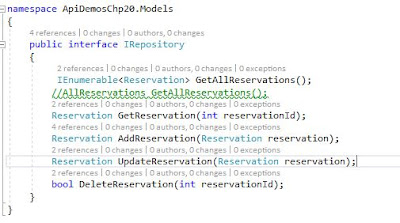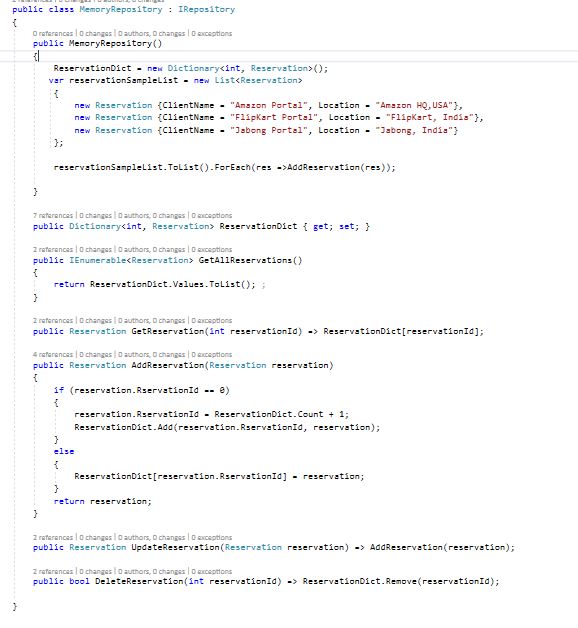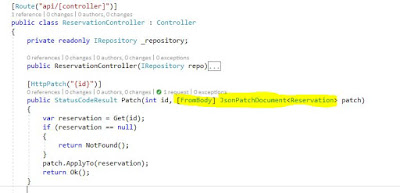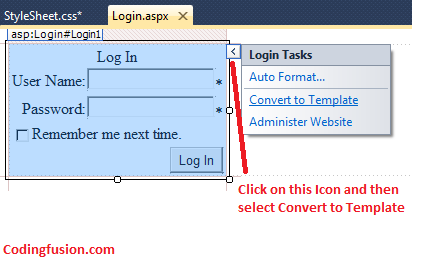JSON Patch in Asp.net Core Webapi
Scenario
Consider following Person entity
{
"id": 1,
"name": "Sam Kwee",
"email": "skwee357@olddomain.com",
"address": "123 Mockingbird Lane",
"city": "New York",
"state": "NY",
"zip": "10001"
}
If there is a requirement to update email address of the person from "skwee357@olddomain.com" to "skwee357@newdomain.com" as shown below
{
"id": 1,
"name": "Sam Kwee",
"email": "skwee357@newdomain.com",
"address": "123 Mockingbird Lane",
"city": "New York",
"state": "NY",
"zip": "10001"
}
We would generally do an HttpPut operation for such partial updates, which incurs updating the entire Person entity, for a minor change of a property (email in this case) .
The disadvantage of such implementation is usage of unnecessary bandwidth, which will eventually effect the performance of webapi.
How do we avoid this ?
Short answer is JSON Patch .
What is JSON Patch ?
JSON Patch is a format for describing changes to a JSON document. It can be used to avoid sending a whole document when only a part has changed.
When used in combination with the HTTP PATCH method, it allows partial updates for HTTP APIs in a standards compliant way. The patch documents are themselves JSON documents.
For example :
Consider the document below
{
"firstname": "Ajay",
"lastname": "Nallanagula"
}The patch
[
{ "op": "replace", "path": "/firstname", "value": "Ajay Kumar" },
{ "op": "add", "path": "/address", "value": ["epam jvp building hyderabad"] },
{ "op": "remove", "path": "/lastname"}
]The result
{
"firstname": "Ajay",
"address":["epam jvp building hyderabad"]
}
How it works ?
A JSON Patch document is just a JSON file containing an array of patch operations.
The patch operations supported by JSON Patch are
- “add”,
- “remove”,
- “replace”,
- “move”,
- “copy”
- “test”.
The operations are applied in order: if any of them fail then the whole patch operation should abort.
JSON Pointer
JSON Pointer defines a string format for identifying a specific value within a JSON document. It is used by all operations in JSON Patch to specify the part of the document to operate on.
A JSON Pointer is a string of tokens separated by
/ characters, these tokens either specify keys in objects or indexes into arrays. For example, given the JSON{
"biscuits": [
{ "name": "Marie Gold" },
{ "name": "Good Day" }
]
}
ex : {"op":"add" , "path":"/biscuits/-" , "value": {"name":"Little Hearts" }}, here the value of path is JSON Pointer.
To point to the array biscuits in the JSON document we use /biscuits.
To point to "Good Day" we use /biscuits/1/name.
To point to the root of the document use an empty string for the pointer.
What if the key value in JSON document have '/' in its name for example : { "foo/bar~" : "football" } ?
In this case we need to escape the characters using ~0 and ~1 ,to form JSON pointer, /foo~0bar~1
If you need to refer to the end of an array you can use
- instead of an index. For example, to refer to the end of the array of biscuits above you would use /biscuits/-. This is useful when you need to insert a value at the end of an array.
Add
Adds a value to an object or inserts it into an array.
Operation : {"op":"add" , "path":"/biscuits/-" , "value": {"name":"Little Hearts" }}
Result : {
"biscuits": [
{ "name": "Marie Gold" },
{ "name": "Good Day" },
{ "name": "Little Hearts" } ]
}
In the below mentioned case of an array, the value is inserted before the given index
Operation : {"op":"add" , "path":"/biscuits/1" , "value": {"name":"Bourbon" }}
Result : {
"biscuits": [
{ "name": "Marie Gold" },
{ "name": "Bourbon" }, //new Item is added here
{ "name": "Good Day" },
]
}
Remove
Operation : {"op":"remove" , "path":"/biscuits" }
Result : Will remove the JSON Array biscuits
Operation : {"op":"remove" , "path":"/biscuits/0" }
Result :
{
"biscuits": [
{ "name": "Good Day" }
]
}
Removes the first element of the array at
biscuits (or just removes the “0” key if biscuits is an object)Replace
Operation { "op": "replace", "path": "/biscuits/0/name", "value": "Britania" }Result :
{
"biscuits": [
{ "name": "Britania" }, { "name": "Good Day" }
]
}
Replaces a value. Equivalent to a “remove” followed by an “add”.
Copy
Operation : { "op": "copy", "from": "/biscuits/0", "path": "/best_biscuit" }
Result : {
"biscuits": [
{ "name": "Marie Gold" },
{ "name": "Good Day" }
],
"best_biscuit" : "Marie Gold"
}
Copies a value from one location to another within the JSON document. Both
from and path are JSON Pointers.Move
Operation : { "op": "move", "from": "/biscuits", "path": "/cookies" }
Result : {
"biscuits": [
{ "name": "Marie Gold" },
{ "name": "Good Day" }
],"cookies" : [
{ "name": "Marie Gold" },
{ "name": "Good Day" }
]
}
Moves a value from one location to the other. Both from and path are JSON Pointers.
Test
Operation { "op": "test", "path": "/best_biscuit/name", "value": "Marie Gold" }
Tests that the specified value is set in the document. If the test fails, then the patch as a whole should not apply.
The HTTP PATCH method is atomic and the patch should only be applied if all operations can be safely applied. The test operation can offer additional validation to ensure that patch preconditions or post conditions are met. If the test fails the whole patch is discarded .Test is strictly an equality check.
How do we make use of JSON PATCH in ASP.NET CORE WebApi ?
NOTE: GET, POST , PUT, DELETE are straight forward operations, In this blog lets focus on PATCH operation.
You can see the source code here .
You can see the source code here .
Step 1: Create a new asp.net core project, select WebApi project template as shown below
Step 2: Lets create these model classes, and Interface, data sources class (ideally these things should be retrieved from persistence storage like DB) for demo purpose this should be fineReservation.cs IRepository.cs
MemoryRepository.cs
Step 3 : Lets configure Startup.cs,Insert the dependency MemoryResspoitory in ConfigureServices
Step 4: Now lets implement WebApi methods , The main focus here is on HTTP PATCH operation , rest of the operations can be seen in source code uploaded on github .
Is this code working ??
Lets test that, I am using postman here , alternatively you can use fiddler, curl and so on.













Comments
Post a Comment